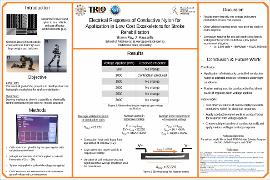| dc.contributor.advisor | Hausselle, Jerome | |
| dc.contributor.author | Ray, Shawn K. | |
| dc.contributor.other | Biomechanical Analysis and Musculoskeletal Modeling Lab of Oklahoma State University | |
| dc.date.accessioned | 2021-03-25T14:28:53Z | |
| dc.date.available | 2021-03-25T14:28:53Z | |
| dc.date.issued | 2020-10-03 | |
| dc.identifier | oksd_OK-LSAMP_2020_ray | |
| dc.identifier.citation | Ray, S., & Hausselle, J. (2020, Oct. 3). Electrical responses of conductive nylon for application in low cost exoskeletons for stroke rehabilitation. Poster session presented at the Oklahoma Louis Stokes Alliance for Minority Participation's 26th Annual Research Symposium, Stillwater, OK. | |
| dc.identifier.uri | https://hdl.handle.net/11244/329035 | |
| dc.description.abstract | Despite the rising popularity of robotic exoskeletons, high cost and bulkiness are two limitations that hinder their popularity and everyday use. Our overarching goal is to develop an electrically powered low-cost lightweight exoskeleton for stroke rehabilitation by expanding upon previous research showing that nylon can be utilized as an artificial muscle. Nylon fishing line and silver coated nylon were used as materials for coil production. Lines were twisted together into coils, keeping consistent contact throughout testing. Voltages were generated, while keeping tension on a coil, using a single channel function generator with frequencies of 1Hz and 2Hz, and voltages ranging from 500mV to 3V in increments of 500mV. Unexpectedly, when voltage was applied to coils no response was seen, except for an observed contracting force at one volt in each frequency. Conductive artificial muscle coils displayed contracting forces with at least one voltage level. Given that coils only responded to one volt and coil resistance did not vary significantly, we infer that the response was produced from a combination of the coils voltage and current level. Current work is focusing on developing more coils that can be tested for a wider range of voltage/current levels. Future work will focus on testing additional conductive nylon varying in resistance. This study represents an important step towards designing artificial muscles that are electrically controlled. These muscles have shown the potential to be electrically powered and controlled, giving promise to electrically powered soft exoskeletons in future work which could replace bulky motor and actuator driven robotics altogether. | |
| dc.description.sponsorship | Oklahoma Louis Stokes Alliance for Minority Participation Program | |
| dc.description.sponsorship | Robert E. McNair Post-Baccalaureate Achievement Program | |
| dc.format | application/pdf | |
| dc.language | en_US | |
| dc.publisher | Oklahoma State University | |
| dc.rights | In the Oklahoma State University Library's institutional repository this paper is made available through the open access principles and the terms of agreement/consent between the author(s) and the publisher. The permission policy on the use, reproduction or distribution of the article falls under fair use for educational, scholarship, and research purposes. Contact Digital Resources and Discovery Services at lib-dls@okstate.edu or 405-744-9161 for further information. | |
| dc.title | Electrical responses of conductive nylon for application in low cost exoskeletons for stroke rehabilitation | |
| osu.filename | oksd_OK-LSAMP_2020_ray.pdf | |
| dc.description.department | Mechanical and Aerospace Engineering | |
| dc.type.genre | Presentation | |
| dc.type.material | Text | |
| dc.subject.keywords | nylon | |
| dc.subject.keywords | artificial muscles | |
| dc.subject.keywords | conductive nylon | |
| dc.subject.keywords | exoskeleton | |
| dc.subject.keywords | rehabilitation | |
